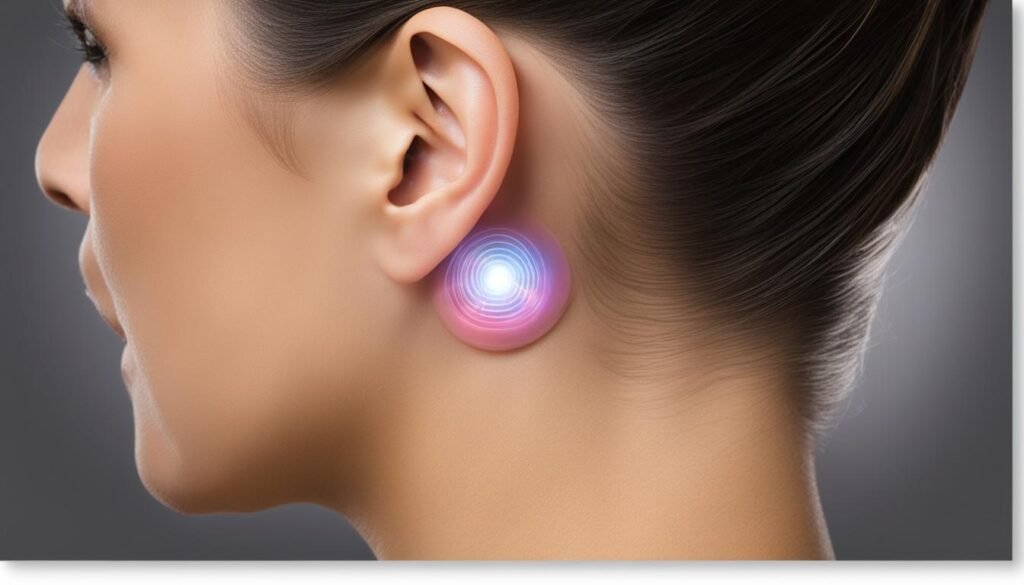Do tinnitus patches work? This query has gained interest following a recent clinical trial by Susan Shore at the University of Michigan, focusing on a novel approach to alleviate tinnitus symptoms. The study involved 99 participants with somatic tinnitus who used a prototype device comprising an in-ear headphone and externally attached electrodes. This unique treatment combined acoustic and electric stimuli to reduce activity in the dorsal cochlear nucleus (DCN), which is believed to be a contributing factor in tinnitus. Remarkably, those in the experimental group reported a significant reduction in tinnitus symptoms, with continued improvement observed even during breaks in treatment. The study’s findings suggest that the beneficial effects of this innovative approach could last up to 36 weeks, offering a ray of hope for individuals struggling with tinnitus.

Key Takeaways:
- Tinnitus patches have shown promising results in reducing tinnitus symptoms.
- A combination of acoustic and electric stimuli is used in the treatment.
- Participants in the clinical trial experienced significant improvement in their tinnitus symptoms.
- The positive effects of the treatment lasted for up to 36 weeks.
- Tinnitus patches offer hope for those seeking relief from tinnitus.
Understanding the Nature of Tinnitus
Tinnitus is characterized by a constant buzzing or ringing in the ears. It can significantly impair the quality of life for those with severe tinnitus. Up to 80 percent of people with tinnitus have the bodily form, in which the noises are generated or altered by head or neck movements. While various treatment options are available for tinnitus, including natural remedies, tinnitus patches have gained attention as an innovative solution.
The bisensory treatment developed by Susan Shore and her team shows promising results in reducing tinnitus symptoms. These patches deliver a combination of acoustic and electric stimuli to the brain, targeting the overactivity of the dorsal cochlear nucleus (DCN) – a potential cause of tinnitus. By individualizing the stimulation level to each person’s tinnitus, the patches aim to relieve the constant noise.
While natural remedies for tinnitus, such as relaxation techniques and sound therapy, can help manage the symptoms for some individuals, they may not be effective for everyone. Tinnitus patches offer a more targeted approach by directly addressing the underlying neuroplastic changes in the brain associated with tinnitus. Further research and development in this field have the potential to advance tinnitus patch treatments and provide effective relief for those suffering from tinnitus.
The Science Behind Tinnitus Patches
Tinnitus patch treatment is rooted in a scientific understanding of the condition. By combining acoustic and electric stimuli, these patches aim to reduce the overactivity of the brainstem’s dorsal cochlear nucleus (DCN), which is believed to be a pivotal contributor to tinnitus. This individualized approach targets the specific stimulation level needed for each person’s tinnitus, offering a personalized treatment experience.
In a recent clinical trial conducted by Susan Shore and her team, participants in the experimental group underwent daily tinnitus patch treatment for 30 minutes over six weeks. The results showed a significant reduction in the perception of tinnitus loudness, with participants reporting that the noise was, on average, half as loud after the study’s first phase.
The combination of acoustic and electric stimuli delivered through tinnitus patches shows promising results in alleviating the constant buzzing and ringing in the ears.
These findings suggest that tinnitus patches have the potential to be an effective treatment option for individuals experiencing tinnitus. However, more research and studies are needed further to evaluate this innovative approach’s long-term effects and benefits. Tinnitus patch reviews from participants in the clinical trial have been overall positive, pointing to the potential effectiveness of these patches in managing tinnitus symptoms.
As researchers continue to delve into the science behind tinnitus and explore new treatment methods, tinnitus patches offer a glimmer of hope for individuals seeking relief from the distressing symptoms of this condition. With further advancements in technology and ongoing research, tinnitus patch treatments may become more widely accessible, providing a viable solution for those affected by tinnitus.
The Perceptual Experience of Silence and Tinnitus
The perception of silence and tinnitus is a fascinating and complex subject. A recent study published in the Proceedings of the National Academy of Sciences sheds light on how people perceive silence as a type of sound. The researchers conducted experiments using sonic illusions to demonstrate that our brains process silence similarly to how they process actual sounds.
The study revealed that when exposed to periods of silence, our brains fill in the gaps with their neural activity, creating a perception of sound even when there is none. This phenomenon highlights the intricate nature of our auditory experiences and how various factors, including tinnitus, can influence them.
“Our study highlights the paradoxical nature of silence and its relationship to tinnitus. While silence is traditionally associated with the absence of sound, our findings show that our brains perceive silence as a type of sound itself. This complex interplay between silence, sound, and tinnitus adds another layer of understanding to the perceptual experience of those living with tinnitus,” explains Dr. Susan Shore, the study’s lead researcher.
The constant noise can overwhelm individuals with tinnitus and disrupt their daily lives. Tinnitus management patches aim to relieve this persistent sound by reducing its perception. By delivering a combination of acoustic and electric stimuli through the patches, the treatment works to decrease the overactivity in the area of the brain believed to be responsible for tinnitus, the dorsal cochlear nucleus (DCN).
The Role of Tinnitus Management Patches
Tinnitus management patches offer a non-invasive and innovative approach to treating tinnitus. The treatment protocol typically involves wearing the patches for a designated period each day, tailored to the individual’s specific tinnitus symptoms. The patches deliver targeted stimulation to the DCN, helping to rewire the brain’s perception of tinnitus and reduce the intensity of the sound.
Do tinnitus gummies work? Learn more in our detailed article, where we explore various aspects and provide valuable insights.
While further research is needed to fully understand the effectiveness of tinnitus management patches, early clinical trial results are promising. The positive outcomes in reducing tinnitus symptoms provide hope for those seeking relief from this persistent condition. With ongoing advancements in tinnitus research and technology, the future of tinnitus patch treatment looks promising.

Note: The image above represents the concept of tinnitus management patches for illustrative purposes only.
The Future of Tinnitus Patch Treatment
Tinnitus relief patches have shown remarkable potential in alleviating the distressing symptoms of tinnitus. The groundbreaking clinical trial conducted by Susan Shore and her team at the University of Michigan has provided hope for millions suffering from this chronic condition. The study’s success has opened up new possibilities for the future of tinnitus patch treatment.
The positive outcomes observed in reducing tinnitus symptoms have paved the way for further research and development in this field. Susan Shore’s innovative bisensory treatment, involving a combination of acoustic and electric stimuli delivered through the patches, has proven effective in reducing the constant buzzing and ringing in the ears.
“The positive effects of the treatment lasted up to 36 weeks,” says Susan Shore, emphasizing the long-term relief potential of tinnitus patches.
The next step for Shore and her team is to navigate the approval process to bring this new treatment method to the market. Tinnitus relief patches offer a ray of hope for those seeking relief from the debilitating effects of tinnitus, providing a potential solution for improved quality of life and enhanced well-being.
Conclusion
The clinical trial conducted by Susan Shore and her team provides compelling evidence of the effectiveness of tinnitus patches in reducing tinnitus symptoms. Through acoustic and electric stimuli delivered directly to the affected area, tinnitus patches have shown promising results in alleviating the constant ear buzzing and ringing.
With the positive outcomes observed during the trial, tinnitus sufferers can find hope in this innovative solution. As further research and development in this field continue, more advanced tinnitus patch treatments may likely be available, offering even more significant relief for individuals struggling with this condition.
While tinnitus can significantly impact one’s quality of life, the successful use of tinnitus patches provides hope. By targeting the underlying causes of tinnitus and providing tailored treatment, these patches offer a potential solution for those seeking relief from constant discomfort. As research progresses, it is clear that tinnitus patch effectiveness is an area that holds promise and deserves further exploration.
Frequently Asked Questions
Do tinnitus patches work?
The clinical trial Susan Shore and her team conducted has shown promising results in reducing tinnitus symptoms using tinnitus patches.
What is the nature of tinnitus?
Tinnitus is characterized by a constant buzzing or ringing in the ears. Up to 80 percent of people with tinnitus have the bodily form affected by head or neck movements.
How do tinnitus patches work?
Tinnitus patches deliver a combination of acoustic and electric stimuli to reduce the overactivity of the dorsal cochlear nucleus (DCN) in the brain stem, which is believed to be a cause of tinnitus.
What is the perceptual experience of silence and tinnitus?
While not directly related to tinnitus patches, a study has shown that people perceive silence much like they hear sounds. Tinnitus management patches aim to reduce the perception of constant noise.
What is the future of tinnitus patch treatment?
The success of the clinical trial conducted by Susan Shore and her team offers hope for the future of tinnitus patch treatment. Further research and development may lead to more advanced tinnitus patch treatments.



